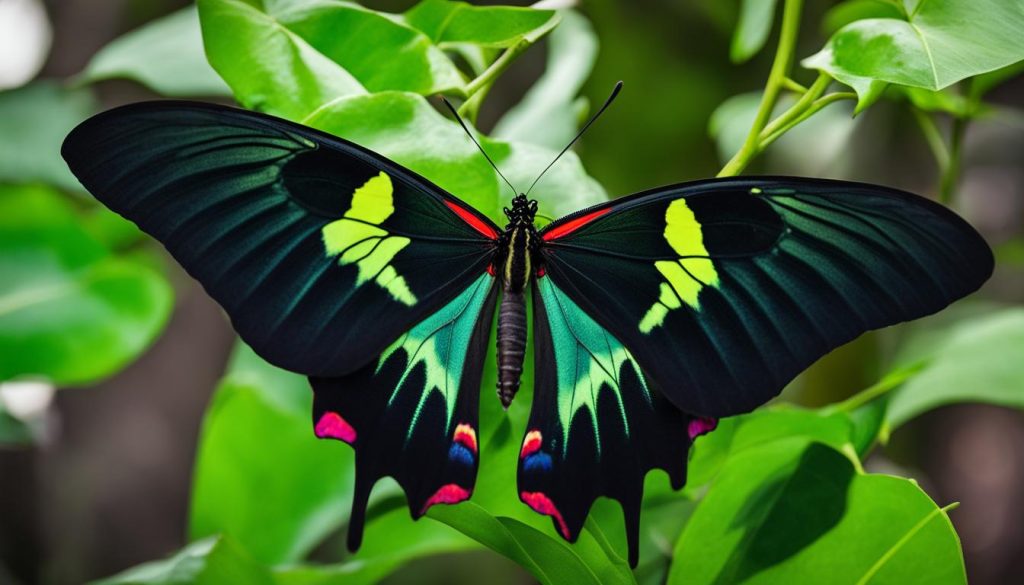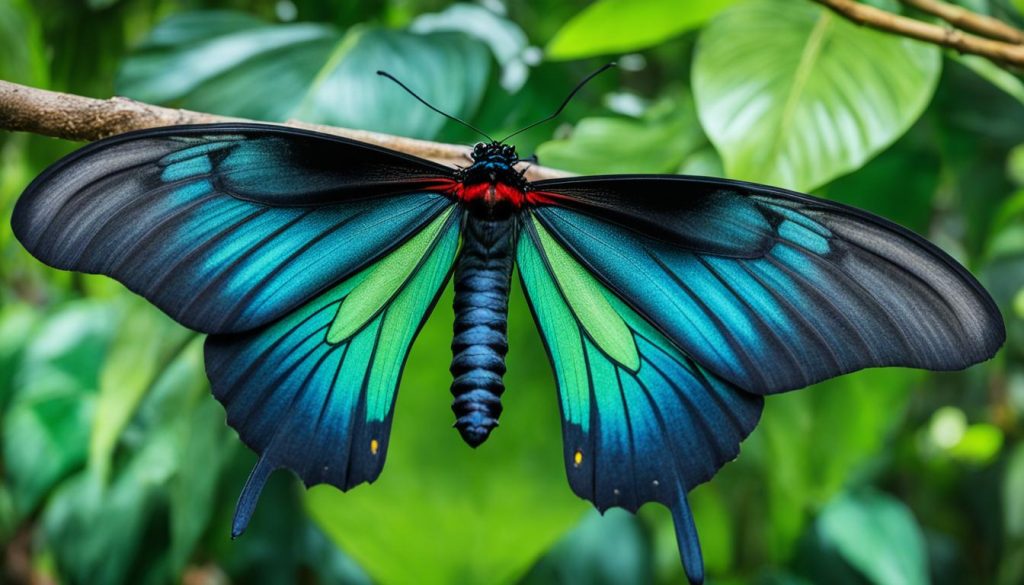Welcome to our article on Queen Alexandra’s Birdwing, the largest butterfly in the world. This magnificent creature is not only a marvel of nature but also an endangered species that needs our attention and conservation efforts. Native to the rainforests of Papua New Guinea, the Queen Alexandra’s Birdwing is a rare butterfly species with a unique habitat.
With its astonishing wingspan and vibrant colors, the Queen Alexandra’s Birdwing captivates all who have the pleasure of witnessing its grace. Unfortunately, the population of this remarkable butterfly is declining rapidly due to habitat destruction and human activities. It is crucial for us to understand the importance of butterfly conservation and take action to protect these delicate creatures.
Key Takeaways:
- Queen Alexandra’s Birdwing is the largest butterfly species in the world.
- It is an endangered species native to the rainforests of Papua New Guinea.
- The butterfly’s habitat is threatened by deforestation and human activities.
- Conservation efforts are essential for preserving this rare butterfly species.
- By raising awareness and implementing sustainable practices, we can contribute to their survival.
Overview of Queen Alexandra’s Birdwing

The Queen Alexandra’s birdwing is the largest butterfly in the world, with females reaching a wingspan of up to 28 cm (11 inches) and males reaching up to 20 cm (9 inches). It is known for its vibrant colors, with the males displaying shimmering emerald green-blue wings and the females having brown wings with rows of white spots and triangles.
This magnificent butterfly species, scientifically known as Ornithoptera alexandrae, is native to Papua New Guinea and is considered an icon of the country’s biodiversity. The Queen Alexandra’s birdwing is a butterfly enthusiast’s dream, with its stunning size and striking patterns capturing the imagination of nature lovers worldwide.
While the females have a larger wingspan, it is the male Queen Alexandra’s birdwing that displays the most dazzling colors, making it a sight to behold. Pairing the vibrant emerald green-blue wings with its large size makes this butterfly an attention-grabber in any rainforest canopy.
“The Queen Alexandra’s birdwing is not only the largest butterfly in the world but also a testament to the incredible diversity and beauty of nature. Its impressive wingspan and vibrant colors make it a symbol of Papua New Guinea’s rich ecological heritage.” – Dr. Olivia Peterson, Butterfly Conservation Society
These butterflies have evolved to have such large wingspans to facilitate their flight and for mating displays. The male’s vibrant colors play a crucial role in attracting females during courtship, demonstrating the elegance and grandeur of this remarkable species.
Comparing Queen Alexandra’s Birdwing with Other Butterflies
| Butterfly Species | Wingspan (Females) | Wingspan (Males) |
|---|---|---|
| Queen Alexandra’s Birdwing | Up to 28 cm (11 inches) | Up to 20 cm (9 inches) |
| Common Buckeye | 3.8 – 6.4 cm (1.5 – 2.5 inches) | 3.8 – 6.4 cm (1.5 – 2.5 inches) |
| Monarch Butterfly | 9 – 10 cm (3.5 – 4 inches) | 7.5 – 8.9 cm (3 – 3.5 inches) |
| Morpho Butterfly | 5.1 – 20.5 cm (2 – 8 inches) | 5.1 – 20.5 cm (2 – 8 inches) |
The Queen Alexandra’s birdwing truly stands out with its massive wingspan, distinguishing itself as the largest butterfly in the world. Compared to other butterfly species, both its females and males surpass them by a significant margin. This impressive size contributes to its uniqueness and magnificence.
The vibrant colors and extraordinary size of the Queen Alexandra’s birdwing make it a beloved subject of photographers and researchers alike. However, the conservation status of this iconic species is a matter of concern due to habitat loss and other threats, calling for immediate action to protect its future existence.
Habitat of Queen Alexandra’s Birdwing
Queen Alexandra’s birdwing butterflies are exclusively found in the rainforests of Papua New Guinea, an island off the northern coast of Australia. These magnificent butterflies inhabit old-growth, coastal rainforests, where they rely on specific plant species, such as the Aristolochia pipevine, for their survival.
However, the Queen Alexandra’s birdwing’s habitat is rapidly declining due to deforestation for timber and the expansion of oil palm plantations. As a result, they have become an endangered species facing the threat of extinction.
The destruction of their rainforest habitat has a severe impact on the population of Queen Alexandra’s birdwing butterflies. The loss of their natural habitat disrupts their life cycle, as well as their ability to find suitable food sources and establish mating grounds.
Conservation efforts are crucial in protecting the remaining rainforest habitats of Queen Alexandra’s birdwing butterflies. By preserving these vital ecosystems, we can ensure the survival and well-being of this remarkable species.
| Threats to Queen Alexandra’s Birdwing Habitat | Conservation Efforts |
|---|---|
| – Deforestation for timber | 1. Establishing protected areas for the conservation of rainforests 2. Enforcing strict regulations on logging 3. Promoting sustainable forestry practices |
| – Expansion of oil palm plantations | 1. Encouraging responsible land use planning 2. Supporting sustainable agriculture practices 3. Promoting the use of substitutes for palm oil |
To protect Queen Alexandra’s birdwing butterflies and their habitat, active measures need to be taken at local, national, and international levels. Collaboration between governments, conservation organizations, and local communities is crucial in preserving the rainforests of Papua New Guinea and maintaining the biodiversity of this unique region.
Life Cycle of Queen Alexandra’s Birdwing

The life cycle of Queen Alexandra’s birdwing includes four stages – egg, larva (caterpillar), pupa (chrysalis), and adult butterfly. The female butterfly lays its eggs on specific species of pipevine plants. The eggs hatch into larvae, which feed on the leaves of the pipevine plant and undergo several molting stages called instars. When the larva is ready, it forms a chrysalis, where it undergoes metamorphosis and transforms into an adult butterfly. This process can take up to a month to complete.
Conservation of Queen Alexandra’s Birdwing
The Queen Alexandra’s birdwing is an endangered species facing the threat of extinction due to habitat loss caused by deforestation. Human activities, such as collecting and the expansion of oil palm plantations, have had a devastating effect on their population. To protect this unique butterfly and preserve its habitat, focused conservation efforts are essential.
Conservation efforts for the Queen Alexandra’s birdwing primarily revolve around protecting their remaining habitat, implementing sustainable farming practices, and raising awareness about their importance in the ecosystem. By taking these actions, we can mitigate the impact of deforestation and contribute to the survival of this magnificent butterfly species.
Protecting Habitat:
Preserving the rainforests of Papua New Guinea, the native home of the Queen Alexandra’s birdwing, is crucial for their survival. Conservation organizations are working alongside local communities and governments to establish protected areas and enforce regulations against deforestation. This ensures that the butterfly’s natural habitat remains intact, providing a sanctuary for their continued existence.
Sustainable Farming Practices:
The expansion of oil palm plantations has been a major contributor to habitat loss for the Queen Alexandra’s birdwing. To address this issue, sustainable farming practices that prioritize the protection of butterfly habitats are being promoted. By encouraging responsible land use and supporting alternative livelihoods, we can reduce the reliance on destructive practices that threaten the butterfly’s habitat.
Raising Awareness:
Education and awareness play a vital role in the conservation of the Queen Alexandra’s birdwing. By highlighting the importance of this endangered species, communities and individuals can make informed choices that promote its preservation. Public campaigns, school programs, and media initiatives are essential tools for fostering a deeper understanding of the butterfly’s ecological significance and the urgent need for conservation efforts.
| Conservation Strategies for Queen Alexandra’s Birdwing |
|---|
| Protecting remaining rainforest habitat |
| Implementing sustainable farming practices |
| Raising awareness through education and media campaigns |
| Establishing protected areas and enforcing regulations |
| Involving local communities in conservation efforts |
The Queen Alexandra’s birdwing is an extraordinary butterfly species that captures the imagination with its beauty and size. By actively supporting conservation initiatives, we can ensure the survival of this endangered species and contribute to the preservation of our planet’s biodiversity.
Conclusion
In conclusion, Queen Alexandra’s birdwing is the largest butterfly species in the world, native to the rainforests of Papua New Guinea. This magnificent butterfly, with its impressive wingspan and vibrant colors, is a true wonder of nature. However, it is also an endangered species, facing the threat of extinction.
The decline in their population is primarily due to habitat loss caused by deforestation and human activities. The rainforests of Papua New Guinea, which serve as their vital butterfly habitat, are being destroyed at an alarming rate. Without immediate action, we risk losing this rare and beautiful species forever.
Butterfly conservation efforts play a crucial role in protecting the remaining habitat of Queen Alexandra’s birdwing and ensuring their survival. By raising awareness about the importance of biodiversity and implementing sustainable practices, we can make a difference. It is up to us to take action and save this remarkable butterfly species for future generations.
FAQ
What is Queen Alexandra’s birdwing?
Queen Alexandra’s birdwing is the largest butterfly species in the world. It is known for its impressive wingspan and unique habitat.
Where is Queen Alexandra’s birdwing found?
Queen Alexandra’s birdwing is native to the rainforests of Papua New Guinea, an island off the northern coast of Australia.
How big is the wingspan of Queen Alexandra’s birdwing?
The female Queen Alexandra’s birdwing can reach a wingspan of up to 28 cm (11 inches), while the males can reach up to 20 cm (9 inches).
What does Queen Alexandra’s birdwing look like?
The males have shimmering emerald green-blue wings, while the females have brown wings with rows of white spots and triangles.
What is the life cycle of Queen Alexandra’s birdwing?
The life cycle of Queen Alexandra’s birdwing includes four stages – egg, larva (caterpillar), pupa (chrysalis), and adult butterfly. The female butterfly lays its eggs on specific species of pipevine plants. The eggs hatch into larvae, which feed on the leaves of the pipevine plant and undergo several molting stages called instars. When the larva is ready, it forms a chrysalis, where it undergoes metamorphosis and transforms into an adult butterfly.
Why is Queen Alexandra’s birdwing endangered?
Queen Alexandra’s birdwing is an endangered species due to habitat loss caused by deforestation. Human activities, such as collecting and the expansion of oil palm plantations, have had a devastating effect on their population.
What can be done to conserve Queen Alexandra’s birdwing?
Conservation efforts for Queen Alexandra’s birdwing focus on protecting their remaining habitat, implementing sustainable farming practices, and raising awareness about their importance in the ecosystem. Breeding programs and reintroductions to protected areas are also being considered to ensure the survival of this unique butterfly species.








